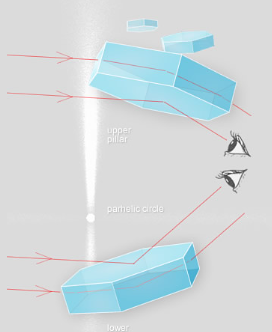Plate crystal pillar formation
Plate Crystal Pillar Formation: A Detailed Exploration
Atmospheric optics never ceases to amaze us with its captivating displays of light phenomena. One such phenomenon is the formation of plate crystal pillars. These mesmerizing pillars grace the sky, casting a stunning glow and adding a touch of enchantment to our surroundings. In this article, we will delve into the intricacies of plate crystal pillar formation, uncovering the factors that contribute to their creation and shedding light on their captivating characteristics.
The Creation of Sun Pillars
Sun pillars, those ethereal vertical columns of light, are predominantly formed by plate-like crystals. These crystals come in a variety of forms, ranging from perfectly shaped ones to larger, more irregular semi-snowflake types. While optical perfection is not a prerequisite for pillar formation, it is often the case that these pillars are the sole halos visible in the sky due to crystal faults or internal defects that hinder the formation of other arcs.
Unraveling the Formation Process
The formation of sun pillars can be understood by tracing the path of light rays. When it comes to plate crystals of good quality, a considerable number of rays enter a side face, undergo total internal reflection an odd number of times from the upper and lower basal faces, and then exit through the opposite side face. The refraction at these two faces is equal, resulting in an uncolored pillar. However, these pillars adopt the colors of the incident sunlight, which can range from vibrant reds to softer hues.
Upper Pillars: Rays Reflected Downwards
Upper sun pillars are created when rays are reflected downwards from the lower faces of tilted crystals. The tilt of these crystals plays a significant role in determining the height of the pillar. In fact, the larger the tilt, the taller the resulting pillar will be. This contrast between sun pillars and other halos is fascinating since most halos achieve their finest displays when crystals are well aligned, while sun pillars thrive in the presence of crystals with large tilts.
Lower Pillars: Reflecting Light Upwards
On the other hand, lower sun pillars form when light is reflected upwards from the topmost crystal face. These pillars add another dimension to the atmospheric spectacle, emanating a sense of depth and wonder. Just like their upper counterparts, the height of lower pillars is influenced by the tilt of the crystals involved.
Exploring the Beauty of Aligned Crystals
While well-aligned crystals are typically sought after for creating stunning halos, sun pillars defy this expectation. Instead, they require crystals with significant tilts to produce their towering splendor. This distinction adds to the allure of these pillars, as they showcase the beauty that can arise from unconventional arrangements and deviations from optical perfection.
With their radiant glow and vertical elegance, plate crystal pillars leave us in awe of nature's artistry. These captivating formations demonstrate the complex interplay of light and crystal structures, resulting in breathtaking displays that adorn our skies. Whether it's the upper pillars formed by downward-reflected rays or the lower pillars created by upward reflections, each pillar tells a unique story of atmospheric optics and the wonders that lie above us.
(Note: This article has been automatically converted from the old site and may not appear as intended.)

Ray paths that create upper and lower sun pillars.
Most sun pillars are formed by plate-like crystals.
Pillar forming plates range from the ideal crystals at left to large and wobbly semi-snowflake varieties.
Optical perfection is unnecessary. Often pillars are the only halo in the sky because crystal faults like side faces blocked by growths or internal defects prevent other arcs from forming.
Upper pillars are created by rays reflected downwards from the lower faces of tilted crystals. In plate crystals of good quality, a significant number of pillar forming rays enter a side face, undergo total internal reflection an odd number of times from the upper and lower basal faces and then leave through the opposite side face. The refraction at the two faces is equal and so the pillar is not coloured. However, pillars adopt the colours of the incident sunlight which may be highly reddened.
Lower pillars form when light is reflected upwards from the topmost crystal face.
Most halos are at their finest when crystals are well aligned. In contrast, sun pillars need crystals with large tilts. The larger the tilts the taller is the pillar.
Note: this article has been automatically converted from the old site and may not appear as intended. You can find the original article here.
Reference Atmospheric Optics
If you use any of the definitions, information, or data presented on Atmospheric Optics, please copy the link or reference below to properly credit us as the reference source. Thank you!
-
<a href="https://atoptics.co.uk/blog/plate-crystal-pillar-formation/">Plate crystal pillar formation</a>
-
"Plate crystal pillar formation". Atmospheric Optics. Accessed on November 26, 2024. https://atoptics.co.uk/blog/plate-crystal-pillar-formation/.
-
"Plate crystal pillar formation". Atmospheric Optics, https://atoptics.co.uk/blog/plate-crystal-pillar-formation/. Accessed 26 November, 2024
-
Plate crystal pillar formation. Atmospheric Optics. Retrieved from https://atoptics.co.uk/blog/plate-crystal-pillar-formation/.